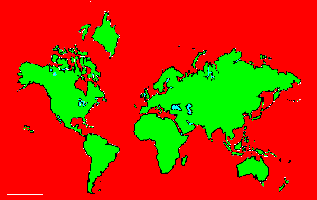SPECIES INFO
Bluntnose sixgill shark (Hexanthus griseus) is a wide ranging, yet local, species that is found in the eastern Pacific Ocean from Alaska to Mexico, and also near Bolivia and northern Chile. In the western Pacfific this is found near Japan, Australia and New Zealand. In the Indian Ocean, it is found north of Madagascar and also near Malaysia and Sumatra. In the western Atlantic Ocean this is found near the Carolinas, Florida, the northern Gulf Coast, Panama, and near Argentina. In the eastern Atlantic, this is found from Scandanavia south to Angola, and also in the Mediterranean. This is generally a deepwater species.
This is a large shark per McClane (1978) that is commonly up to 15 feet with a record over 26 feet. Compagno (2005) notes the maximum is probably near 18 feet. Eschmeyer(1983) notes the record for is 15.5 feet. Robins (1986) to 16 feet. This shark is pale colored with a darker dorsal side. Near Europe this shark is found as deep as 6,000 feet below sea surface, but typically between 1,000 and 2,000 feet below the surface.The sixgill and seven gill family (Hexanchidae) is a small family found almost worldiwde. There are only four species in this family. Members of this family have a single dorsal fin set further back on the body. The body turns upwards to extend almost to the tail tip.
Order Hexanchiformes contains two families. The frilled sharks (Chlamydoselachidae) and the six gilled and seven gilled sharks (Hexanchidae) belong here. There are only 6 known species in this order.
Sharks and rays (Elasmobranchi), cartilaginous fishes, deserve to be a class separate from the normal fish, in that they do not have a bone skeleton but rather a cartilage skeleton.
Fertilization is internal in this class which also separates them from the bony fish class. Although there are a few fresh water species, the majority of the species in this class are found in salt water. As of 2005, there were about 500 known species of sharks and about 600 known species of rays.
David Ebert, author of a recent book on sharks, rays, and chimaeras of California, counts a total of 988 described species in the class with about 150 additional species awaiting scientific description. He breaks down the described species to 410 species of sharks, 543 species of rays, and 35 species of chimaeras.
Many species of sharks face an uncertain future, as the Chinese purchase shark fins to make shark fin soup. It was estimated that 100 milllion sharks are killed each year for this purpose. However, recent estimates indicate the Chinese are reducing their consumption of this exotic soup.
Backboned Animals (Phylum Chordata) are the most advanced group of animals on earth. These animals are characterized by having a spinal cord or backbone. Most members have a clearly defined brain that controls the organism through a spinal cord. Fish, amphibians, reptiles, birds, and mammals are in this phylum.
Currently, some taxonomists believe that the fish should be divided into two groups (sharks and regular fishes) and that there are some other primitive groups in the phylum such as hagfish or lampreys.
Animal Kingdom contains numerous organisms that feed on other animals or plants. Included in the animal kingdom are the lower marine invertebrates such as sponges and corals, the jointed legged animals such as insects and spiders, and the backboned animals such as fish, amphibians, reptiles, birds, and mammals.

